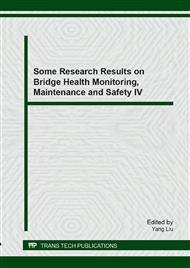[1]
G.H. Zhang, Y.J. Ge, Vibration characteristics test and analysis on concrete box girder continuous pedestrian bridge, J. Vib. Shock, 28(2) (2009) 102-106.
Google Scholar
[2]
D.W. Zhang, Pedestrians comfort evaluation of the Dalian Gangwan Bridge under moving vehicular loads, Rail. Eng., (3) (2007) 5-7.
Google Scholar
[3]
Z.C. He, B.S. Wang, Vibration measurement and analysis of large span footbridge, J. Vib. Shock, 25(4) (2006) 138-141.
Google Scholar
[4]
W. Liu, Y. Li, B.W. Li. Measured analysis of pedestrian comfortableness on an overpass under metro vibration, Under. Eng. Tun., (2) (2007) 36-38.
Google Scholar
[5]
L.M. Sun, X.F. Yan. Human walking induced footbridge vibration and its serviceability design, J. Tongji Uni. (Nat. Sci.), 32(8) (2004) 996-999.
Google Scholar
[6]
Z.H. Zong, C.L. Lai, Z.H. Xia, Variability in dynamic characteristic and comfort evaluation of a pretressed concrete continuous girder bridge, Earth. Eng. Eng. Vib., 26(1) (2006) 71-77.
Google Scholar
[7]
B.C. Chen, J.G. Wei, J.P. Wang, Research on deflection limit value for CFST arch bridge, China J. High. Trans., 20(6) (2007) 56-60.
Google Scholar
[8]
L. Li, Z.X. Ye, X. Wang, et al, Riding comfort of long-span suspension bridge under moving loads, J. High. Trans. Res. Dev., (09) (2007) 46-50.
Google Scholar
[9]
W.S. Han, A.R. Chen, Effects of crosswind and bridge motion on ride comfort of road vehicles, China Civ. Eng. J., 41(04) (2008) 55-60.
Google Scholar
[10]
G.B. Wang, W.P. Xie, Y.L. Yu, et al, Study on floor vibration comfort of wuhan railway station under the running condition of high speed train, J. Vib. Shock, 29(12) (2010) 110-113.
Google Scholar
[11]
A.S. Nowak, H.N. Grouni, Serviceability considerations for guideways and bridges, Can. J. Civ. Eng., 15(4) (1988) 534-538.
DOI: 10.1139/l88-073
Google Scholar
[12]
A. Shahabadi, Bridge vibration studies, Indiana Department of Transportation and Purdue University, West Lafayette, Indiana, 1977.
Google Scholar
[13]
E.R. Mao, H. Zhang, Z.H. Song, Ergonomics in vehicle engineering, Beijing Institute of Technology Press, Beijing, 2007.
Google Scholar
[14]
B.Q. Zhang, L. Li, Dynamic model and comfort evaluation of a body-vehicle-road coupled system, J. Vib. Shock, 30(1) (2011) 1-5.
Google Scholar
[15]
International Organization for Standardization, ISO 2631-1 Mechanical vibration and shock evaluation of human exposure to whole-body vibration, Part 1: Genaral requirements, The Organization, Switzerland, 1997.
DOI: 10.3403/30197820
Google Scholar
[16]
Q.X. Wu, B.C. Chen, K. Takahashi, et al, Vehicle- bridge dynamic analysis and riding comfort evaluation of New Saikai Bridge, J. High. Trans. Res. Dev., 25(5) (2008) 61-67.
Google Scholar
[17]
W.M. Zhai, H. Xia, Train-track-bridge dynamic interaction: theory and engineering application, Science Press, Beijing, 2011.
Google Scholar
[18]
B.Q. Guo, Study on driving comfort of cable-stayed bridges with moving vehicles, Harbin Institute of Technology, Harbin, 2013.
Google Scholar
[19]
C.H. Wang, Z.L. Wang, Dynamic analysis on coupled vehicle-bridge system by modal synthesis method, J. High. Trans. Res. Dev., 23(12) (2006) 76-80.
Google Scholar
[20]
Q.F. Gao, Z.L. Wang, B.Q. Guo, et al, Design on dynamic performance of highway bridges to moving vehicular loads, Key Eng. Mater., 574 (2014) 43-51.
DOI: 10.4028/www.scientific.net/kem.574.43
Google Scholar
[21]
E.S. Hwang, A.S. Nowak, Simulation of dynamic load for bridges, J. Struct. Eng., 117(5) (1991) 1413-1434.
DOI: 10.1061/(asce)0733-9445(1991)117:5(1413)
Google Scholar
[22]
Q.F. Gao, Z.L. Wang, B.Q. Guo. Modified formula of estimating fundamental frequency of girder bridge with variable cross-Section, Key Eng. Mater., 540 (2013) 99-106.
DOI: 10.4028/www.scientific.net/kem.540.99
Google Scholar
[23]
X.S. Wang, J.G. Cui, Impact coefficient of long- span suspension bridge, J. Chongqing Jiaotong Uni. (Nat. Sci.), 32(sup.1) (2013) 848-851.
Google Scholar
[24]
W.S. Han, T. Wang, Y.Q. Li, Analysis system of vehicle-bridge coupling vibration with grillage method based on model updating, China J. High. Trans., 24(5) (2011) 47-55.
Google Scholar
[25]
L. Zhou, Study on dynamic response and fatigue performance of large-span bridges to wind and vehicle loadings, Tongji University, Shanghai, 2008.
Google Scholar


